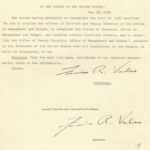Students will use a facsimile of a vetoed bill and veto message to understand the veto and veto override process in Congress. Referring to the Constitution, students will match the Constitution’s directions to the markings and language of the bill and veto message. Students will then investigate motives for using the veto and override powers, and how the powers reflect the Constitution’s checks and balances.
How a Bill Becomes a Law – Clean Water Act of 1972
The Federal Water Pollution Control Act, commonly known as the Clean Water Act, was originally passed in 1948. By 1972, Congress had voted on an amended version of the law that included the expansion of regulations to prevent pollution of the nation’s waterways. In this lesson, students consider how the Clean Water Act of 1972 became a law. They identify key moments in the evolution of this bill including its path in Congress, its veto by President Nixon and its eventual enactment. Preparing and organizing information, students interpret these key events and share them in a storyboard presentation. While intended for 8th grade students, the lesson can be adapted for other grade levels.
Constitutional Index – Presidential Veto Clause
The Constitutional Index breaks down the U.S. Constitution by Section, Amendment, and Clause and contains broader topics and themes. These are used to cross-reference Library resources in an effort to annotate constitutional history.
Constitutional Index – Reconsideration of Veto Clause
The Constitutional Index breaks down the U.S. Constitution by Section, Amendment, and Clause and contains broader topics and themes. These are used to cross-reference Library resources in an effort to annotate constitutional history.
Constitutional Index – Veto Override Clause
The Constitutional Index breaks down the U.S. Constitution by Section, Amendment, and Clause and contains broader topics and themes. These are used to cross-reference Library resources in an effort to annotate constitutional history.
Constitutional Index – Pocket Veto Clause
The Constitutional Index breaks down the U.S. Constitution by Section, Amendment, and Clause and contains broader topics and themes. These are used to cross-reference Library resources in an effort to annotate constitutional history.
Structures, Powers, and Functions of Congress
Teachers can assign the materials in this lesson as homework or use them to create stations in their classroom in which students can understand how the House of Representatives and Senate differ in their structures, powers, rules, and functions. After students have gone through the lesson, teachers can assign one of two practice exercises to assess how much they understood from their lesson.
Court Shorts: Separation of Powers
In a five-minute video, federal judges offer insights into their thinking about the separation of powers and describe how healthy tensions among the branches have a stabilizing effect on democracy. The judges also share their respect for and commitment to this founding principle, which has an impact on everyday American life.
